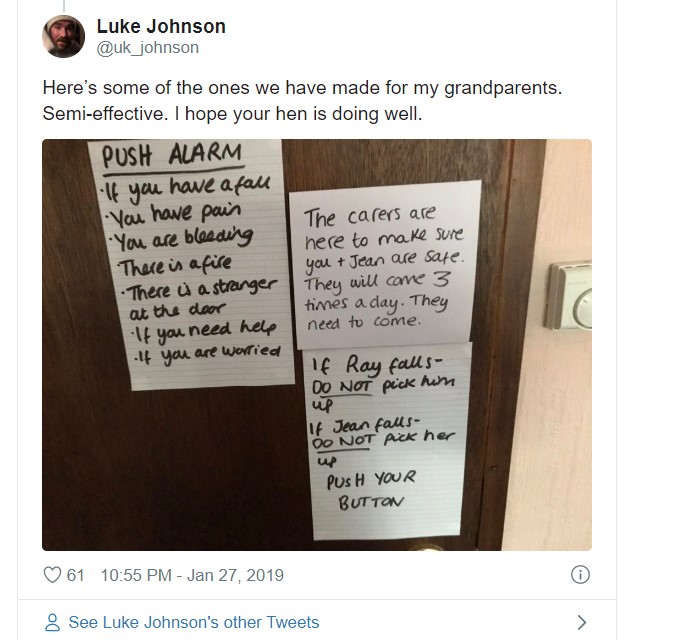Dementia Whiteboard: 3 Key Benefits of Using Whiteboards in Aged Care and Medical Facilities
Share
Heartbreaking. Family, friends, or caregivers of people with dementia will know just how degenerative the disease is. Dementia is an overall term for diseases and conditions characterised by a decline in memory, language, problem-solving and other thinking skills that affect a person’s ability to perform everyday activities. Using a dementia whiteboard can provide a big difference in caregiving.
Dr Philip Grimmer, from Wiltshire in the United Kingdom, was visiting one of his patients with the disease when he saw the words of reassurance written on a whiteboard by a daughter to her mother that he decided to share on Twitter.

“Words of reassurance left for an elderly lady with dementia by her daughter,” Dr Grimmer explains. “A simple white board left in her sight line in her sitting room. Helped to reduce constant anxious phone calls.”
Dementia Whiteboard – 3 Key Benefits of Using One
#3 Improving Patient-Staff Communication
A key benefit of the use of whiteboards within medical facilities is improving communication between the medical care team, the patient, and concerned family members. Dry-erase whiteboards in patients’ rooms serve as a means of communication easily accessed by both staff and family members. Important information concerning treatment schedules, diet options, allergies, medication times, and care team members can be easily recorded and changed on a whiteboard. When used properly, this offers information as to where a patient is when out of the room for treatment and what goals or tests are set to be accomplished during a shift and also provides a place for the patient and family to record any concerns or questions they may have. When the patient or family members have access to a whiteboard, communication is improved because a question is less likely to be overlooked or forgotten if a staff member is not immediately available to provide an answer. Family contact information is also easily available at a glance, and family members can update their contact information as needed.
#2 Dementia Whiteboards Help Ease Anxiety
It’s simple, caring, and re-assuring. It helps ease anxiety of both parties. The elderly and the care provider.
“Your meals are paid for
You’re okay
Everyone’s fine
You are not moving
No-one else is moving
Keep drinking, it will help your memory
You don’t owe anyone any money
You haven’t upset anyone.”
Dr Grimmer’s tweet garnered over 40,000 likes and 7,000 retweets. Dr Grimmer explained to the BBC that he’d initially posted the tweet to share it with his colleagues. “I’d not seen anything like it before in thousands of house visits. It’s caring, reassuring and sensible – it’s just such a simple idea,” he added.
#1 Boosting Efficiency and Patient Care Quality
Communication, patient safety, and patient care quality can all benefit from the use of whiteboards in a hospital or clinic setting. Often, clinics are a frenzy of activity, with patients quickly being moved from one area to another for evaluation or treatment. The use of a whiteboard quickly communicates where a patient is as well as the staff assigned to the care and treatment of that patient. Patient safety needs are easily communicated concerning allergies or assistance that may be needed for walking or transferring from bed to chair. With the recording of arrival time to the clinic as well as departure times and destinations, efficiency is improved as unnecessary delays are avoided.
Take a look at other whiteboards published by a few twitter users:
Hailley, a nurse from Canada, added:
“I had one resident where I worked who would be in tears because he was worried about his children and having to pay for his meals.”
“It was sometimes tough to reassure him. We had to call his children to talk to him a few times. It was hard to see him so upset.”
She expanded on her comment for the BBC:
“I have seen people talk down to those with dementia, which is just not right. They are still adults who know when they are being treated differently.”
“People just do not know how to interact with them. It takes patience and you may not be able to have a conversation with them in the same way you would with someone without dementia.”
“The whiteboard addresses what gets asked the most [by those] in long-term care.”


Sources:
- https://www.magnatag.com/blog/post/the-benefits-of-having-whiteboards-in-hospitals-medical-centers-and-clinics
- https://megaphone.upworthy.com/p/doctor-dementia-whiteboard?fbclid=IwAR0wjtkimovYuzBGpLu7z4bfH0DbUz52aN_48oOHwB23NuqTFODgny-7U2E












